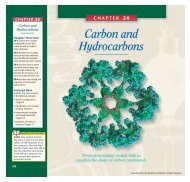You also want an ePaper? Increase the reach of your titles
YUMPU automatically turns print PDFs into web optimized ePapers that Google loves.
Section 9-3<br />
Demonstration 7<br />
<strong>Fluid</strong> flow around a<br />
table-tennis ball<br />
Purpose Introduce students to<br />
some of the interesting effects of<br />
fluid flow.<br />
Materials table-tennis ball glued<br />
to the end of a piece of light<br />
string, water faucet<br />
Procedure Tell the class that this<br />
section covers the surprising<br />
phenomena of fluids in motion<br />
“sucking in” things around them.<br />
Hold the end of the string so<br />
that the ball is a few centimeters<br />
below the faucet but away from<br />
the stream path. When you turn<br />
on the faucet, the ball is attracted<br />
to the water.<br />
Demonstration 8<br />
<strong>Fluid</strong> flow through two<br />
cans<br />
Purpose Further introduce the<br />
effects of fluid flow.<br />
Materials two soda cans, flat<br />
surface<br />
Procedure Lay the soda cans on<br />
their sides approximately 2 cm<br />
apart on a table or other flat surface.<br />
Ask students what would<br />
happen if you were to blow air<br />
between the two cans. Ask a student<br />
volunteer to blow between<br />
the cans. The cans will move<br />
toward each other. Explain that<br />
the air moves faster between the<br />
cans, lowering the pressure<br />
between them and drawing<br />
them together.<br />
332<br />
9-3 SECTION OBJECTIVES<br />
• Examine the motion of a<br />
fluid using the continuity<br />
equation.<br />
• Apply Bernoulli’s equation to<br />
solve fluid-flow problems.<br />
• Recognize the effects of<br />
Bernoulli’s principle on fluid<br />
motion.<br />
332<br />
Chapter 9<br />
9-3<br />
<strong>Fluid</strong>s in motion<br />
FLUID FLOW<br />
Figure 9-10<br />
The water flowing around this cylinder exhibits laminar<br />
flow and turbulent flow.<br />
ideal fluid<br />
a fluid that has no internal<br />
friction or viscosity and is<br />
incompressible<br />
Have you ever gone canoeing or rafting down a river? If so, you may have<br />
noticed that part of the river flowed smoothly, allowing you to float<br />
calmly or to simply paddle along. At other places in the river, there may have<br />
been rocks or dramatic bends that created foamy whitewater rapids.<br />
When a fluid, such as river water, is in motion, the flow can be characterized<br />
in one of two ways. The flow is said to be laminar if every particle that<br />
passes a particular point moves along the same smooth path traveled by the<br />
particles that passed that point earlier. This path is called a streamline. Different<br />
streamlines cannot cross each other, and the streamline at any point coincides<br />
<strong>with</strong> the direction of fluid velocity at that point. The smooth stretches of<br />
a river are regions of laminar flow.<br />
In contrast, the flow of a fluid becomes irregular, or turbulent,<br />
above a certain velocity or under conditions that can<br />
cause abrupt changes in velocity, such as where there are<br />
obstacles or sharp turns in a river. Irregular motions of the<br />
fluid, called eddy currents, are characteristic of turbulent flow.<br />
Examples of turbulent flow are found in water in the wake of<br />
a ship or in the air currents of a severe thunderstorm.<br />
Figure 9-10 shows a photograph of water flowing past a<br />
cylinder. Hydrogen bubbles were added to the water to<br />
make the streamlines and the eddy currents visible. Notice<br />
the dramatic difference in flow patterns between the laminar<br />
flow and the turbulent flow. Laminar flow is much easier<br />
to model because it is predictable. Turbulent flow is<br />
extremely chaotic and unpredictable.<br />
The ideal fluid model simplifies fluid-flow analysis<br />
Many features of fluid motion can be understood by considering the behavior<br />
of an ideal fluid. While discussing density and buoyancy, we assumed all of<br />
the fluids used in problems were practically incompressible. A fluid is incompressible<br />
if the density of the fluid always remains constant. Incompressibility<br />
is one of the characteristics of an ideal fluid.<br />
The term viscosity refers to the amount of internal friction <strong>with</strong>in a fluid. Internal<br />
friction can occur when one layer of fluid slides past another layer. A fluid <strong>with</strong><br />
a high viscosity flows more slowly through a pipe than does a fluid <strong>with</strong> a low<br />
viscosity. As a viscous fluid flows, part of the kinetic energy of the fluid is<br />
Copyright © by Holt, Rinehart and Winston. All rights reserved.
















